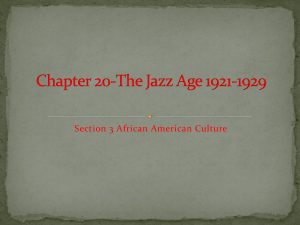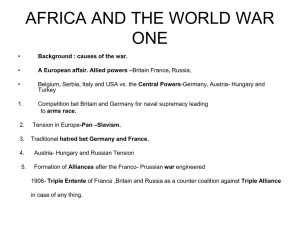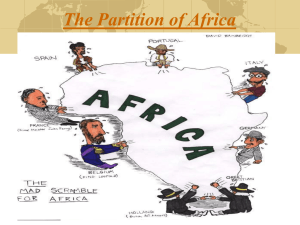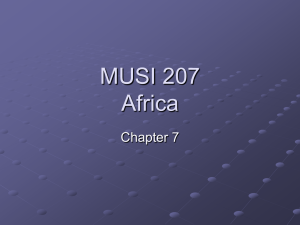Chapter 13: AFrica
advertisement
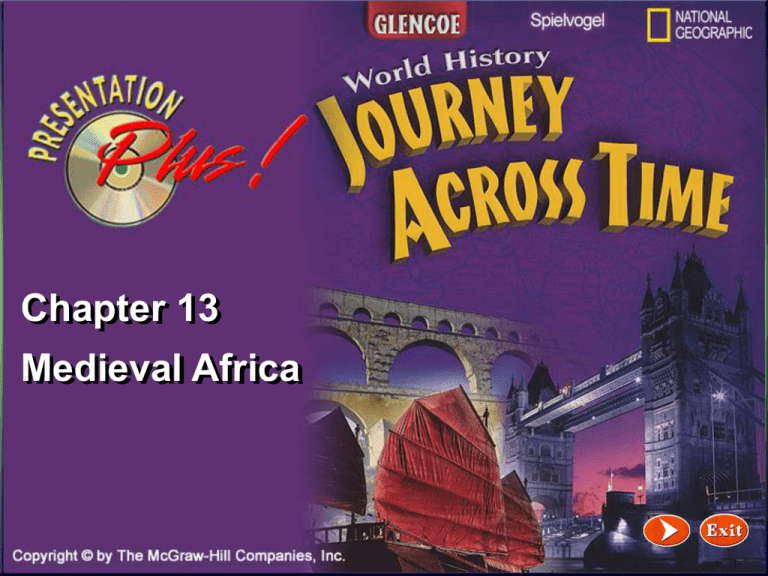
Chapter 13 Medieval Africa Click the mouse button or press the Space Bar to display the information. Medieval Africa Chapter Introduction Section 1 The Rise of African Civilizations Section 2 Africa’s Government and Religion Section 3 African Society and Culture Reading Review Chapter Assessment Click on a hyperlink to view the corresponding slides. Medieval Africa Click the speaker button to play the audio. The Rise of African Civilizations Africa’s Geography • Africa is the second-largest continent in the world. • The African continent contains rain forests; savannas, which are tropical grasslands; and deserts. • The Sahara Desert is in Africa • The Sahara is the largest desert in the world. (pages 445–446) Click the mouse button or press the Space Bar to display the information. The Rise of African Civilizations Africa’s Geography (cont.) • A plateau is an area of high, flat land. • Almost all of Africa, except the coastal plains, rests on a plateau. • The Nile River is Africa’s longest river. • (pages 445–446) Click the mouse button or press the Space Bar to display the information. The Rise of African Civilizations West African Empires (cont.) • Camels could travel for days without water and stored fat in their humps for food. • Trade prospered after the introduction of the camel, and rulers of cities began to build empires. (pages 447–449) Click the mouse button or press the Space Bar to display the information. The Rise of African Civilizations How did the deserts affect travel in Africa? The deserts were difficult to cross. People avoided the desert by traveling along the coastlines. Click the mouse button or press the Space Bar to display the answer. The Rise of African Civilizations East Africa (cont.) • Cities arose on the East African coast to support Arab-African trade. • Zimbabwe was a great trading city. (pages 451–453) Click the mouse button or press the Space Bar to display the information. Africa’s Government and Religion Islam in Africa • Islam was popular in West African cities where Africans traded with Muslim Arabs, but not all West Africans accepted Islam. (pages 464–467) Click the mouse button or press the Space Bar to display the information. Africa’s Government and Religion Traditional African Religions • Many African groups believed in one supreme god. • African religious practices vary from place to place, but their beliefs served similar purposes—to help people stay in touch with their history and provide rules for living. • Many Africans believed the spirits of dead relatives stayed with them when they died and that the spirits could talk to the supreme god. (page 463) Click the mouse button or press the Space Bar to display the information. African Society and Culture Get Ready to Read (cont.) Focusing on the Main Ideas • The African slave trade changed greatly when Muslims and Europeans began taking captives from the continent. Click the mouse button or press the Space Bar to display the information. African Society and Culture Life in Medieval Africa • They spread their language, Swahili, and their culture as they traveled. • Africans often lived with extended families, or families made up of several generations. (pages 469–470) Click the mouse button or press the Space Bar to display the information. African Society and Culture Life in Medieval Africa (cont.) • Many African villages were matrilineal, meaning the people traced their ancestors through their mothers rather than their fathers. (pages 469–470) Click the mouse button or press the Space Bar to display the information. African Society and Culture Life in Medieval Africa (cont.) • Families and villages taught children the history of their people and the skills they would need as adults. • Stories were passed down through wordof-mouth, and lessons were given through short sayings called proverbs. Click the mouse button or press the Space Bar to display the information. (pages 469–470) African Society and Culture Slavery • Slavery existed in Africa before the arrival of Europeans. • Africans enslaved criminals and enemies captured in war. • The slave trade grew as trade with Muslim merchants increased. • Muslims were not allowed to enslave other Muslims, but they could enslave people of other faiths. (pages 472–473) Click the mouse button or press the Space Bar to display the information. African Society and Culture Slavery (cont.) • The Portuguese brought enslaved Africans to Europe in 1441. • These enslaved people were used to farm crops of cotton, grapes, and sugar cane. (pages 472–473) Click the mouse button or press the Space Bar to display the information. African Society and Culture Slavery (cont.) • In the late 1400s, Europeans established sugar plantations in the Americas and brought enslaved Africans to work the fields. (pages 472–473) Click the mouse button or press the Space Bar to display the information. Medieval Africa Review Main Ideas Section 2 Africa’s Government and Religion Describe the religious beliefs of medieval Africans. Some people believed in traditional African religions and their gods. Others were followers of Christianity or Islam. Click the mouse button or press the Space Bar to display the answer. Geography and Climate Zones in Africa Trade in East Africa African Religions Today Focus on Everyday Life Africa’s Salt Mines Salt mining began in the Sahara in the Middle Ages. Ancient miners worked underground and in sand dunes to extract solid blocks of salt. The salt trade became a successful business for the African people. In ancient times, salt was so desirable that it was traded ounce for ounce for gold. There are many salt deposits in western Africa because part of the desert was once a shallow sea made up of salt water. When the sea dried up, salt was left behind. People need a small amount of salt to stay healthy. It is lost when people and animals sweat, so people need some in their food. In ancient times, before refrigerators or canned foods were invented, salt was used to keep foods from going bad. It also was used to add flavor to food. Connecting to the Past 1. How do salt deposits form? As salty water dries, it leaves behind the salt in salt deposits. 2. Why do you think salt was so valuable that it was traded ounce for ounce for gold? It was needed to keep people healthy and to preserve and flavor food. Click the mouse button or press the Space Bar to display the answer. Mansa Musa Ruled 1312–1337 Click the speaker button to play the audio. Queen Nzinga c. 1582–1663 Click the speaker button to play the audio.



